Hungary: bloody autumn 56
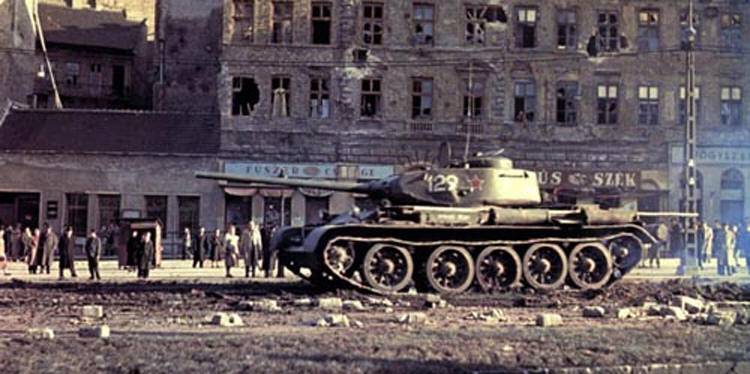
For the last quarter of a century, historians and the media have tried to present the notorious Hungarian events of 1956 of the year as spontaneous speeches by the Hungarian people against the bloody pro-Soviet regime of Matthias Rakosi and his successor, Ernö Gerö. Referred to in Soviet times as a counter-revolutionary rebellion after the destruction of the Soviet Union, these events acquired the resounding name of the Hungarian revolution 1956 of the year. However, was it really that clean? stories? Or did the timely intervention of the Soviet Army prevent Hungary from falling victim to the first Orange Revolution? Let us try to remember how the events developed sixty years ago.
In 1956, Hungary became the scene of tragic events. For several weeks in Budapest and several other cities of the country and localities there was a struggle. The internal opposition, with the active support of external forces, especially the United States and the Federal Republic of Germany, sought to change the socialist system to the capitalist system and wrest the country from the influence of the Soviet Union. The catalyst for the Hungarian unrest was the events in Poland, where Vladislav Gomulka, who was recently released from prison, became the head of the ruling Polish United Workers' Party (PUWP) 19 in October 1956. This choice went across the interests of the Soviet Union, but the Soviet government did not interfere in the internal affairs of Poland, despite the fact that Soviet troops were stationed there. The Hungarian opposition and Western analysts came to the conclusion that in Hungary you can repeat the Polish version.
As it later became known, not only American intelligence was directly involved in the preparation of a coup in Hungary, but also directly the President’s Office, and the US Congress. On the eve of 1956, during a meeting of Hungarian emigration, which came to Munich by Rockefeller, an adviser to the American president, a plan of subversive activities was laid out, for which the CIA developed and secretly circulated in Hungary a program to overthrow the existing system. In January 1956, the US Military Intelligence prepared a report entitled “Hungary: Activity and Resistance Potential,” in which Hungary was viewed from the point of view of US special forces actions. The report noted the peculiarities of the current sentiment in Hungary, which consisted in the anti-Slavic and anti-Semitic feelings of certain groups of the population and in sympathy for fascist Germany, which ensured in 1940-1941. significant territorial gains of Hungary. All this, in the opinion of American intelligence officers, facilitated the “transfer of discontent to the phase of active resistance.”
In the summer of 1956, the United States Congress, in addition to 100 000 000 dollars allocated each year to conduct subversive work against socialist countries, also allocated 25 000 000 dollars. American newspapers openly reported that these funds were intended to "finance actions similar to those that led to the unrest in Poland." The influential circles of the Federal Republic of Germany also contributed to the preparation of a counterrevolutionary coup in Hungary. In particular, according to the newspaper “New York World Telegram and Sun”, the organization of the former Hitler's General Gehlen played an important role in this matter. Special camps functioned in West Germany, where Gelene’s American instructors and scouts, as well as members of Hungarian fascist organizations, conducted training for subversive work in Hungary. In addition, long before the outbreak of the insurgency, a number of points were opened for recruiting hortist and other emigre scum and preparing it for subversive work. There were collected the remnants of the Horty army and gendarmerie, which managed to escape in the West. Passing a certain amount of training with American money, they went to Hungary. One of these points was in Munich.
At the same time, in England, detachments of counter-revolutionaries were recruited, several hundred people each, for transfer to Hungary. In France, armed groups were also trained. Trained terrorists and saboteurs groups in groups of several people were concentrated in Austria, from where they were smuggled across the Austro-Hungarian border to Hungary. This was done with the assistance of the Austrian border service, ensuring their unimpeded transition.
It should be said that by this time, by decision of the Hungarian government, all the barriers on the Austro-Hungarian border were removed, and the border guard was sharply weakened. In essence, anyone could freely move from Austria to Hungary, of course, the organizers of the insurgency used this widely. In the fall of 1956 of the year, former general of the Hortist Army, Hugo Shonya, declared that there was a combat-ready corps of eleven thousand fighters capable of launching actions in Hungary. The American representative, Major Jackson, promised the necessary material assistance and transportation for the transfer of these forces.
The activities of the well-known radio stations Voice of America and Free Europe, which in their programs constantly instigated the overthrow of people's power, opposed the reform and nationalization of enterprises, fanning the leadership of the Hungarian Party of Workers and the government, intensified. Since the summer of 1956, they have strengthened calls for the violent overthrow of the state system in Hungary, while reporting that the Hungarians, who had emigrated to the West, have already launched active preparations for the coup. At the same time, underground work, especially among students and intellectuals, of the fascist fascist elements intensified within the country.
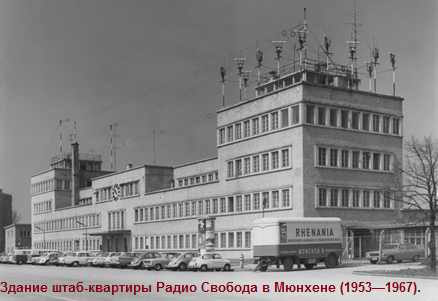
A special role in the October events was played by the party opposition headed by Imre Nagy and Geza Losonczy. Their true intentions were revealed only during the defeat of the rebellion. As it became known, Nagy and Losonczy actively participated in the preparation of the uprising, and also led the rebel forces in its course. Under the leadership of Imre Nagy at the end of 1955, an anti-state conspiracy was prepared long before the uprising began to seize power.
In January of the following year, he wrote an article “Some pressing issues”, in which he proposed to abandon the workers' power and outlined a plan to restore the multi-party system, conclude an alliance with various forces that opposed socialist transformations. In his other article, The Five Basic Principles of International Relations, he substantiated the ideas of liquidating the Warsaw Pact organization. These documents were illegally distributed among the population by members of the group and persons loyal to Nagy. His group widely used legal opportunities for undermining and discrediting people's power, especially when working among intellectuals. The true meaning of the “Hungarian road of socialism” Nadia revealed during the insurrection, when the opposition started to implement the previously developed plans to change the state system in the Hungarian People's Republic.
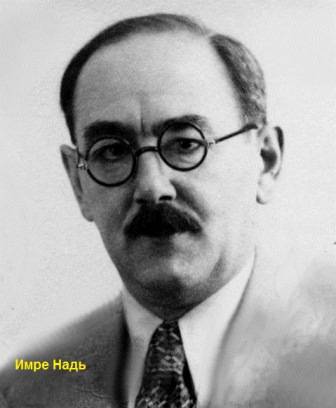
Demagogic agitation caused by the activities of a certain part of the intelligentsia, especially the Petofi Circle, also played a major role in the preparation for the rebellion. The “Petofi Circle”, which emerged in 1955 for the propaganda of the ideas of Marxism-Leninism among young people, was used entirely for other purposes, and events aimed against the people’s power were held under the guise of discussions. Thus, the anti-government insurgency in Hungary was not an accidental or spontaneous phenomenon, it was prepared in advance and carefully prepared by internal opposition forces with active support of international reaction.
After the war, at the request of the Hungarian government, the Soviet troops of the Special Corps were temporarily deployed in the country in various cities; they were not in Budapest. Parts of the corps strictly according to the plan were engaged in combat training, a lot of tactical exercises were conducted, as well as exercises, including live firing, firing and driving courses were worked out tanks, armored personnel carriers, cars. Much attention was paid to the training of flight personnel aviation units, specialists of combat arms and special troops, as well as saving weapons and military equipment. According to the memoirs of the officers of the Special Corps, friendly relations were established between the Soviet soldiers and the population. Good and honest relationships persisted until the summer of 1956. Then the Soviet military began to feel the influence of enemy propaganda among the population and personnel of the Hungarian army, and relations with some Hungarian military units became complicated.
The corps command has learned that the “Petofi Circle” is holding discussions with attacks on the GTA, young people are being called on to anti-government actions. Articles were printed in the press that slandered the existing system, undermined the authority of the government, and hostile forces called for anti-state speeches. Information was received about the frequent trips of American and British military attaches to Austria to communicate with the Hungarian emigration in the West, and also that the programs of Radio Free Europe in the Hungarian language and in the propaganda literature dropped from balloons were heard to speeches against the republic.
On October 10, 23 reported on the radio and in press that the government of the People’s Republic of Hungary was prohibited from holding a student demonstration, but at one o'clock there was a new message about the permission of this demonstration and that the HWT instructed party members to take the most active part in it. So in Budapest 23 October 1956, a demonstration began, in which about two hundred thousand people participated. For the most part these were students and intellectuals, as well as part of the workers, members of the party and the military.
Gradually, the demonstration began to acquire a clear anti-government character. The chanting of slogans began (mostly from a sixteen-point program developed by members of the Petofi Circle), demanding to restore the Hungarian national emblem, cancel military training and Russian language lessons, return the old national holiday instead of the Day of Liberation from Fascism, hold free elections, create a government headed by Imre Nagy and withdraw the Soviet troops from Hungary. Demonstrators began to tear down the signs of the State Emblem from the flags of the People's Republic of Hungary, then burn red flags. Under the cover of the demonstration, armed groups began their actions. In order to seize weapons, they committed organized attacks on the buildings of the regional centers of the Hungarian Voluntary Union for the Defense of the Motherland, which were almost not guarded. During these raids, the rebels kidnapped more than five hundred rifles, pistols and several thousand rounds of ammunition. Also, the rebel arsenal was replenished with weapons that they were able to take from the soldiers of the Hungarian People’s Army. Then armed gangs (it’s difficult to pick a different term) began attacking police departments, barracks, armories and factories.
After just two hours after the start of the student demonstration, armed units began to capture the most important military and government facilities. On the streets of Budapest, again in an organized manner, trucks appeared from which they distributed weapons and ammunition. Machines with armed soldiers of the Hungarian People’s Army could not make their way into the city center. In some places, the rebels disarmed the soldiers, and often the latter themselves joined the anti-government and gangster detachments.
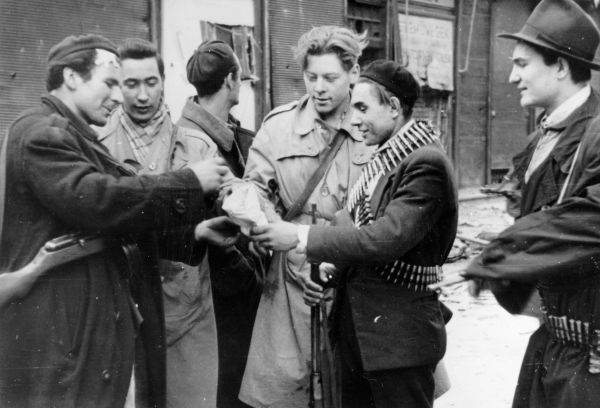
As it became known later, the leaders of the anti-government uprising prepared in advance for the armed uprising. All their actions were aimed at defeating the state and party apparatus in the shortest possible time, demoralizing the army, creating chaos in the country in order to complete their affairs under these conditions. On October 23, around eight o'clock in the evening, terrorists spread a rumor around Budapest that "students are being killed at a radio committee." This is extremely agitated population. In fact, the state security officers guarding the radio committee did not shoot, although armed fascist bandits tried to seize the building and even shot at the crowd. Only after midnight, when there were already many dead and wounded among the protection of the radio committee, did the guard receive an order allowing the firing to take place.
However, several students and elderly men managed to break into the radio studio. They called themselves delegates from those gathered on the street and demanded to immediately interrupt the transfer, remove the microphone from the building and read out the 16 items of the “requirements”, which among other things insisted on the need for the withdrawal of Soviet troops from Hungary. At 20-00, the first secretary of the Central Committee of the Volunteer Labor Ministry Erne Here spoke on the radio, but his speech was not heard by the crowd at the radio committee. At this time, machine-gun and assault rifles were already bursting in many areas of the city. State Security Major Laszlo Magyar, who stepped outside the gates of the radio studio to persuade people to disperse, was killed.
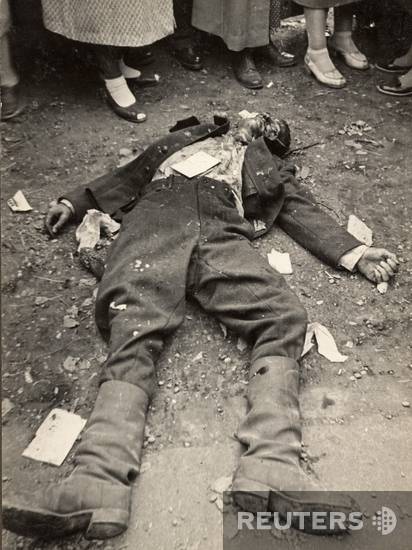
On the night of October 24, the rebels attacked the editorial board of the Sabad Nep party newspaper, a telephone exchange, the main and district police departments, arms depots and factories, barracks, bases and garages, and freight traffic offices. Bridges over the Danube were captured. Only those vehicles whose passengers called the established password: “Petofi” could follow the Margit bridge. A cursory analysis of these events shows that the rebels were prepared in advance and had their own military command center. With the seizure of the radio station and the editorial offices of the Sabad Nep newspaper, they deprived the party and the government of the means of forming public opinion in the country; seizing weapons and ammunition in warehouses, weapons factories, police departments and barracks, they armed anti-government forces; the seizure of vehicles expanded the possibilities of maneuver by the forces of the rebels.
In order to carry out their plan, the rebels were also formalized. Armed detachments and groups of declassed and criminal elements were created, weapons depots were organized, the most advantageous positions were seized.
At the beginning of the rebellion, the antigovernmental forces did not meet with any serious resistance from the forces of people's power. Even in the district police departments they seized weapons without any resistance. When reports from the district police departments about the appearance of “demonstrators” demanding weapons began to arrive at the police headquarters, the head of the department, lieutenant colonel Sandor Kopachi, ordered the rebels not to shoot or interfere. The crowd gathered in front of the police headquarters. When those who appeared demanded the release of prisoners, as well as the removal of the red stars from the façade, Sandor Kopaci immediately unconditionally fulfilled these requirements. The actions of the police chief caused jubilation. Shouts were heard in his address: “Appoint Shandor Kopachi as Minister of the Interior!” It later became known that Kopachi was a member of an underground counter-revolutionary center created by a group of accomplices of Imre Nagy to provide direct leadership of the rebel forces.
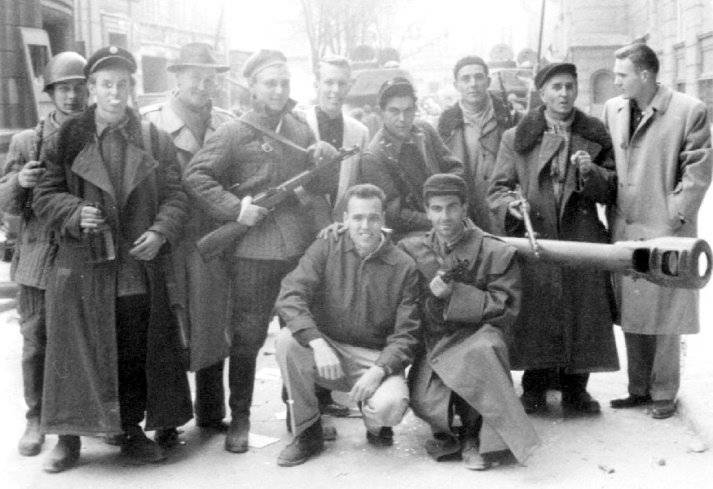
The criminal activity of Kopachi was not only to transfer weapons to the rebels, but also to disorganize the activities of the Budapest police, with his knowledge, more than 20 thousands of firearms fell into the hands of the rebels. The events of October 23 and the following night clearly showed that an anti-state insurgency was unleashed in Budapest under the guise of a student demonstration. However, Imre Nadi’s accomplices, entrenched in the building of the headquarters of the police, everything that was happening was represented by the “revolution”, the democratic movement of the Hungarian people.
On the night of October 24, Imre Nagy headed the government and became a member of the Politburo of the Central Committee of the HWP, and his supporters occupied important posts in the state and the party. This was the next step in the implementation of the Nadya group’s plan, which, of course, was not known to the HVT Central Committee. On the same night, an emergency meeting of the Central Committee of the Hungarian Workers' Party was held, where recommendations to the government were prepared. It was proposed to immediately arm the working people who were loyal to the cause of revolution and with arms to start actions against the rebels, and also use the help of Soviet troops to defeat the counter-revolution, declare a state of emergency in the country.
Imre Nagy, who also took part in the work of this meeting of the Central Committee of the party, approved all the proposed measures without expressing a single objection. However, this was mere hypocrisy. He was not going to uphold the existing state system and the orientation of Hungary to the USSR. The plan was diametrically opposed and included the gradual ousting of all Communists and people oriented towards the socialist development from the top leadership, and subsequently - the implementation of these measures throughout the country; decomposition of the army and police; the collapse of the state apparatus.
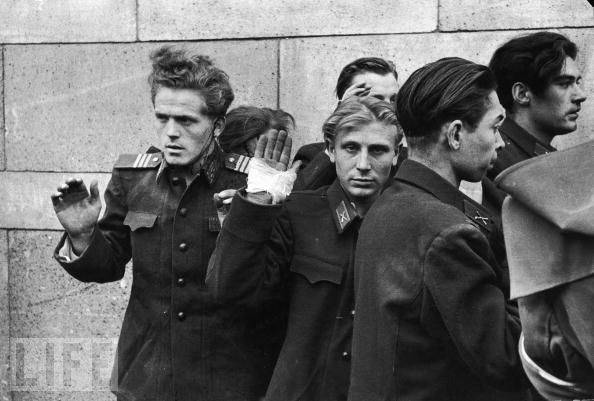
In the current situation, the government of the People's Republic of Hungary and the Central Committee of the Great Patriotic Party appealed to the Soviet government with a request for assistance by Soviet troops to restore law and order in the capital of Hungary. The Government of Hungary sent a telegram to the USSR Council of Ministers as follows: "On behalf of the Council of Ministers of the Hungarian People’s Republic, I request the Government of the Soviet Union to send Soviet troops to Budapest for help in order to eliminate the unrest in Budapest, to quickly restore order and create conditions for peaceful constructive labor."
October 24 1956 from the General Staff of the USSR Armed Forces issued a decree on the advancement of Soviet troops in Budapest with the task of assisting the garrison of the Hungarian troops in the elimination of the armed insurrection. On the same day, parts of the Special Corps began their advancement to the Hungarian capital from Kecskemet, Cegléd, Székesfehérvár and other districts. They needed to go from 75 to 120 kilometers.
The actions of the Soviet troops in Hungary deserve a separate series of articles (which, if the topic turns out to be interesting to readers, will be prepared later, as well as a story about the role of Western intelligence services in organizing events and promoting an armed uprising), this review sets out the general coverage of chronology events.
The Commander of the Special Corps and the operational team of the headquarters left for Budapest from Szekesfehervar. The column consisted of cars, radio stations, several armored personnel carriers and tanks. When the group entered the city, on its streets, regardless of the late time, there was a revival, trucks with armed groups of civilians rushed through, and a crowd rallied in the center. Everywhere, people were torching with torches, flags, banners in their hands, sharp sounds of gunfire were heard from all sides, and separate gunfire. To the building of the Ministry of Defense of the Hungarian People’s Republic it was impossible to pass through the central streets, the task force could hardly move along the narrow streets. When one of our radio stations lagged behind the column, it was immediately attacked by the rebels. The head of the radio station was wounded in the head, one radio operator was killed. The radio station was overturned and burned. A group of soldiers sent in to help with a tank and an armored personnel carrier rescued the surviving crew members.
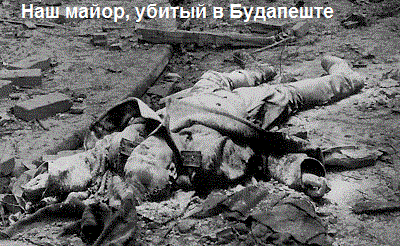
The command post of the Commander of the Special Corps was located in the building of the Ministry of Defense, since there was a government contact of HF with Moscow, which facilitated interaction with the Hungarian command. The nervous and panic atmosphere reigned in the Ministry of Defense of the People's Republic of Hungary, the incoming data on the events and actions of the Hungarian military units and the police were contradictory. Defense Minister Istvan Bata and the General Staff Layosh Toth were in a depressed state, giving conflicting orders. So, when the rebels attacked the armories, an order followed from the General Staff: do not shoot. Terrorists were already firing everywhere. It was ordered to send the Hungarian military to strengthen the protection of objects, not giving them ammunition (allegedly in order to avoid bloodshed). Taking advantage of this, the rebels seized weapons from the soldiers.
As soon as the Commander of the Special Corps appeared in the General Staff of the Armed Forces of Hungary, the Central Committee of the Hungarian Workers' Party, the Ministry of Defense asked him to strengthen the defense of the most important objects, to protect the buildings of party district committees, police departments, barracks, various warehouses, as well as apartments of some officials. All this required a large number of troops, and corps connections to Budapest have not yet arrived.
When the 2 and 17 units of the mechanized divisions approached Budapest, the commander of the Special Corps set the tasks for the commanders. The advancing advanced units were ordered to take parliament under guard of the building of the Central Committee of the TTP. MFA, bank, airfield, bridges over the Danube, weapons and ammunition depots; knock out the rebels from the building of the radio committee, railway stations, as well as to ensure the protection of the Ministry of Defense, disarm the rebels and transfer them to the Hungarian police.
At the entrance to the city, armed rebels fired at Soviet units, and barricades were set up on the outskirts of the city. The residents of the city reacted in different ways to the appearance of Soviet troops, as the participants in those events recalled: some smiled, shook hands, thereby showing their good disposition, others shouted something irritably, others were gloomy in silence, and in some places they suddenly opened fire. Soviet troops were subjected to organized fire from automatic weapons in the streets of Yullei, Markushovski, Hungaria Avenue, as well as on the approaches to a number of objects. Our units entered the battle and cleared the rebels from the Sabad Nep editorial office, the Central Telephone Exchange, railway stations and military depots. The shootout broke out in the center and in the southeast of the city: near the building of the radio committee, in the area of the Kirvin cinema on Yllei Street. It became known that in addition to Budapest, riots began in other Hungarian cities: Szekesfehervar, Kecskemete.
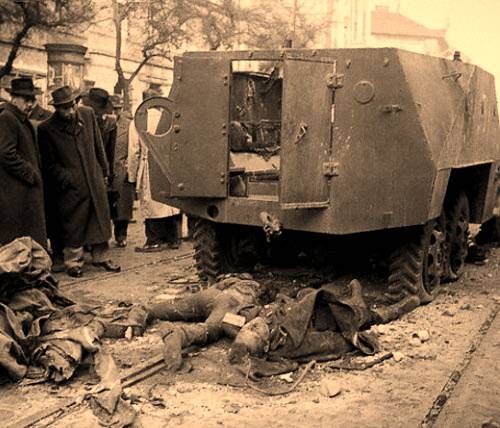
At noon, the Hungarian radio announced a government decree introducing a state of emergency in the Hungarian capital. A curfew was set up until 7 in the morning, a ban was declared on holding rallies and meetings, military field courts were introduced. The rebels were asked to lay down their arms on October 24. Those who did not fulfill this requirement were threatened by a court martial.
It seemed that the armed insurgency was largely over. Already the Budapest radio reported that there were only a few pockets of resistance. The shootout has weakened somewhat. However, 25 and 26 of October mass riots from Budapest spread to other cities. In many Hungarian settlements, so-called “revolutionary committees” appeared, which seized power. They were usually led by hortist officers, representatives of the West-oriented part of the students and intellectuals. The rebels freed fascists and criminals from prisons, who, replenishing the ranks of the rebels, taking with them the dominant position in the established authorities, intimidated and persecuted supporters of the country's socialist course.
The command of the Special Corps continued to receive information that armed émigrés rushed across the Austrian border, who were not obstructed by the border guards. At that time, Imre Nagy, without notifying the party leadership and without the consent of the Soviet command, in the morning of October 25 lifted the curfew, the ban on group gatherings and demonstrations. Endless meetings, meetings of “revolutionary committees” were held at enterprises and institutions, leaflets and appeals were read, new anti-state requirements were developed. Some units of the army and the police disintegrated under the influence of the events that took place, which made it possible for the rebels to seize a significant amount of weapons with ammunition. Part of the construction battalions, anti-aircraft units, as well as officers of the Budapest Garrison, went over to the side of the rebels. By the morning of October 28, the rebels with large forces held the southeastern part of Budapest (100-120 quarters), a number of objects in Buda and other areas, subjected the city to cross-fire and attempted to seize Soviet weapons and military equipment in groups. Decisive action was needed, and the government of Imre Nadia forbade our troops to open fire.
The expansion of the republic’s armed forces was one of Imre Nagy’s main objectives. He decided it was time to do it directly. First of all, Nagy ordered the dissolution of the administration and state security organs, legitimized the armed forces of the rebels, covering them with the sign of the “National Guard Units” and including the so-called “armed forces to protect the internal order”. They also included the police. A “Revolutionary Committee of the Armed Forces of the Internal Order” was formed to lead these armed forces, which also included representatives of the rebels. His leader, Nagy, appointed Bela Kiray, a former officer of the Hortist General Staff, who was sentenced to death by espionage in 1951, replaced by life imprisonment. Naturally, in the days of rebellion he was released. Subsequently, Imre Nagy confirmed Major-General Bela Kirai to the post of chairman of the “Revolutionary Committee of the Armed Forces for the Protection of Internal Order” and ordered him to form the national guard primarily from the “groups that participated in the revolutionary battles”, i.e. rebel battles.
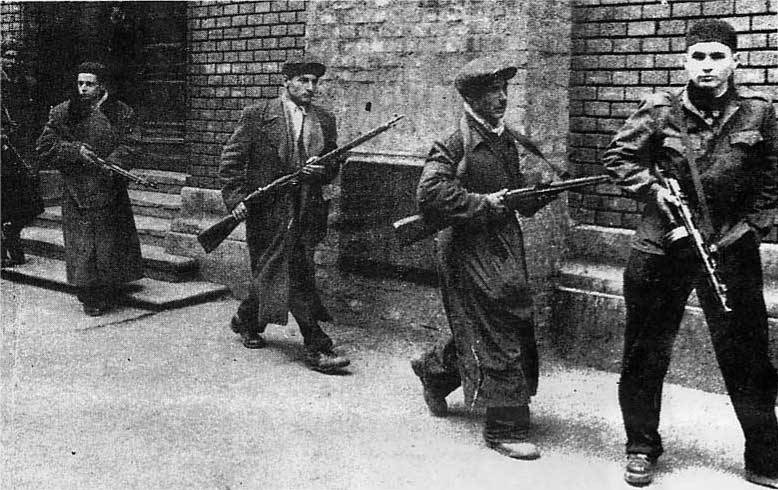
Bela Kiray went further and asked Imre Nadi to control both the Ministry of Defense and the Ministry of the Interior in order to clear them of the "rakoshists." Now the rebels were provided with weapons from the arsenals of the army and the Interior Ministry. So, only from one warehouse, located on the street Timot, was issued about 4000 carbines, rifles, machine guns and machine guns. It should be noted that from the peripheral warehouses, despite orders from B. Kiray, no weapons were issued to the rebels.
October 30 in the 17 watch the Imre Nagy government announced the requirement for the withdrawal of Soviet troops from Budapest. The night of October 31, in accordance with the decision of the Soviet government, began the withdrawal of our troops from the Hungarian capital. By the end of the same day, our troops were completely withdrawn from the city. This was the end of the first stage of the struggle against the armed rebellion in Hungary.
After the withdrawal of Soviet troops to the outskirts of Budapest, counter-revolutionary gangs, inspired by Imre Nagy’s support, began a real terror against the communists, state security workers and others oriented towards socialism and the Soviet Union. They organized pogroms of buildings of party and state bodies, demolished monuments to Soviet soldiers-liberators. Fascists and criminals released from prisons joined the ranks of the rebels, thus reinforcing the rampant terror. A total of about 9500 criminals were released and armed - murderers, robbers and thieves, and 3400 political and war criminals. The Khortist-fascist forces created their own political groups, like mushrooms after the rain, various kinds of reactionary parties began to appear, the so-called “Democratic People’s Party”, “Catholic People’s Union”, “Christian Front”, “Hungarian Revolutionary Youth Party” and many others appeared. . All these elements sought to get into government bodies as soon as possible, to occupy leading posts in the Ministry of Defense. It was under their pressure that the government appointed General Bela Kirai, commander of the Budapest garrison, as military commander, and General Pal Maxster, minister of defense, as military commander.
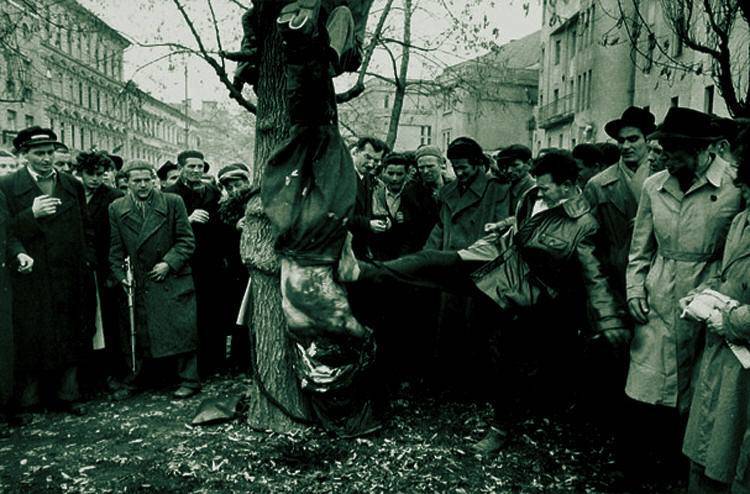
At the end of October, throughout the Austro-Hungarian border, the “national guardsmen” were in charge, opening the state border to their supporters. Who just did not carry turbid wave of counter-revolution across the border. Hortystas, Nilaschists, counts and princes, fascist thugs from the “crossed arrows” and the “Hungarian legion”, barons, generals, terrorists who graduated from special schools in the USA and West Germany, military fighters of all professions and specialists in street battles since the times of the fascist coup. The fascist-hortist scumbags were not inferior to the Hitlerite punishers in terms of cruelty and atrocities committed. They burned down the Hungarian communists, trampled them to death with their feet, pierced their eyes, broke their arms and legs. Having seized the Budapest Party Committee, the rebels hanged Colonel Lajos Sabo by the feet on a steel cable and tortured him to death. Thousands of people in those days became the victims of the terror of those who are now called "representatives of democratic forces."
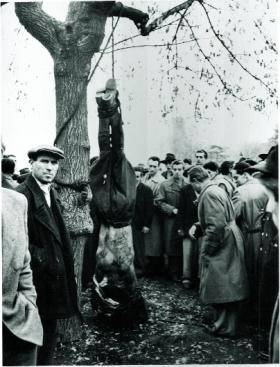
Many soldiers of the Hungarian army actively participated in the defeat of the gangs of the rebels. For example, Major Vartolan led the rout of a gangster group led by a former SS officer. However, the Hungarian People’s Army was unable to independently crush the forces of the armed uprising. Some troops were on the side of the rebels. The leadership of the Ministry of Defense was demoralized by events and could not control the army. Major-General Pal Mageter, head of the police, Sandor Kopaci, and the hortist military leadership, led by Bela Kiraly, who came to the side of the rebels, agreed on actions against the Soviet troops in early November.
The Soviet command saw the processes taking place in Hungary and was very concerned about the transfer of power into the hands of virtually fascist forces. And how to deal with the Nazis, while in our country they knew well. And there was only one way to combat this infection. November 2 March 1956 Commander-in-Chief of the United Armed Forces of the Warsaw Pact (OVS VD) Marshal of the Soviet Union I.S. Konev summoned the commander of the Special Corps to Szolnok and assigned him the combat mission of eliminating the armed insurrection in Budapest. To solve this problem, the corps was reinforced with tanks, artillery batteries and airborne troops.
3 November, at two o'clock in the morning, in accordance with the directive of the commander-in-chief of the Allied Air Force and the approved plan of the operation, the Special Corps forces were assigned the task of "defeating the counterrevolutionary forces in Budapest." At dawn 4 in November, according to the established signal, signifying the start of the operation, the detachments formed to capture the objects and the main forces of the divisions that followed the routes in the columns rushed into the city and with decisive actions, overcoming the resistance of the rebels, immediately entered Budapest. By 7 h 30 mines, they already controlled the bridges across the Danube, cleared from the rebel parliament, the buildings of the Central Committee of the HWP, the Ministry of Internal Affairs, the Ministry of Foreign Affairs, the city council, the Nogoti station and other objects. The government of Imre Nagy has lost power in the country. Nagy himself, with some of his comrades-in-arms, as soon as Soviet troops began to enter Budapest, left parliament through the back door, having made a message on the radio that allegedly “the government remains in place”, and found refuge in the Yugoslav embassy, where it asked shelter
During the day of the battle, Soviet troops disarmed the rebels around 4000 rebels, captured 77 tanks, two artillery warehouses, 15 anti-aircraft batteries, a huge number of small arms. Attempts to seize the square "Moscow", the Royal Fortress and neighborhoods adjacent to the Gellert Hill from the south were unsuccessful because of the stubborn resistance of the rebels. As our units moved to the center of the city, the rebels put up more and more fierce and organized resistance, especially near the Central Telephone Exchange, in the Korvin area, the Kalion barracks and the Keleti station. To master the foci of resistance, where the rebels were 300-500, the commanders were forced to attract significant forces.
Part of the Soviet troops under the command of generals A. Babajanyan, X. Mansurov cleared other settlements of the country from insurgents. As a result of the actions of the troops of the Special Corps, an armed counter-revolutionary rebellion was eliminated both in the capital and throughout the country. Having stopped the armed struggle, the remnants of the rebels went underground.
The quick defeat of the armed anti-government uprising was facilitated by the fact that the insurgents could not receive broad popular support. Too quickly, the true face of the “freedom fighters” and the essence of the order they set up became clear. In the midst of the struggle, from 4 to 10 in November, the rebel armed forces were barely replenished. To their credit, and perhaps even to ordinary rationality, Hungarian officers must be said that, contrary to Imre Nagy's orders, they did not lead their units and units into battle against the Soviet Army. After the rebellion was liquidated, the Soviet Army proceeded to ensure the normalization of life in the country. Military trucks delivered food, medicine, building materials, etc.
By the end of December, the situation in Hungary has changed significantly. This was especially felt in Budapest. Everywhere began work enterprises and government agencies. At schools and higher educational institutions classes normally went. Smooth running urban transport. Destruction was quickly eliminated. Across the country, the work of the people's police, the judiciary and the prosecutor's office was being streamlined. However, shots from the corner, committed by gangs left over from the time of the insurrection, attempting to terrorize the population, continued.
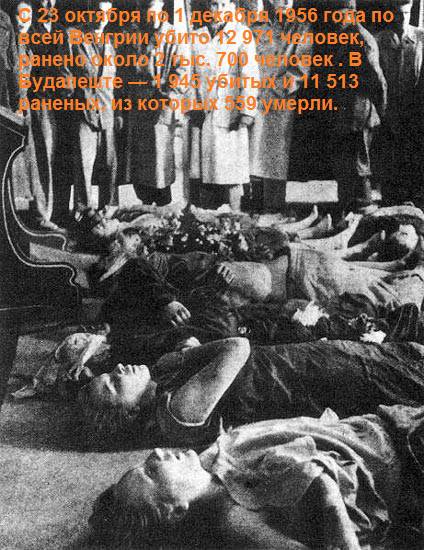
Sources:
Lavrenov S., Popov I. The Soviet Union in local wars and conflicts. M .: ACT; Astrel, 2003. C.142-185.
Gavrilov V. "Black October" 1956-th // Top Secret. 8 November 2006.
Berez Janos. The collapse of Operation Focus. M .: Politizdat. 1986. C. 32-87.
Laschenko P. Hungary, 1956 year // VIZH. 1988. No.8. C.42-50.
Mazov V., Pulyakh A. Simakin M. On the events in Hungary. Facts and documents. M .: Gospolitizdat, 1957. C. 101-103.
Bulah S. Hungary 1956. Essays on the history of the crisis. M .: Science, 1993. C. 63-90.
Kostin B. Margelov. M .: Young Guard, 2005. C.104-114.
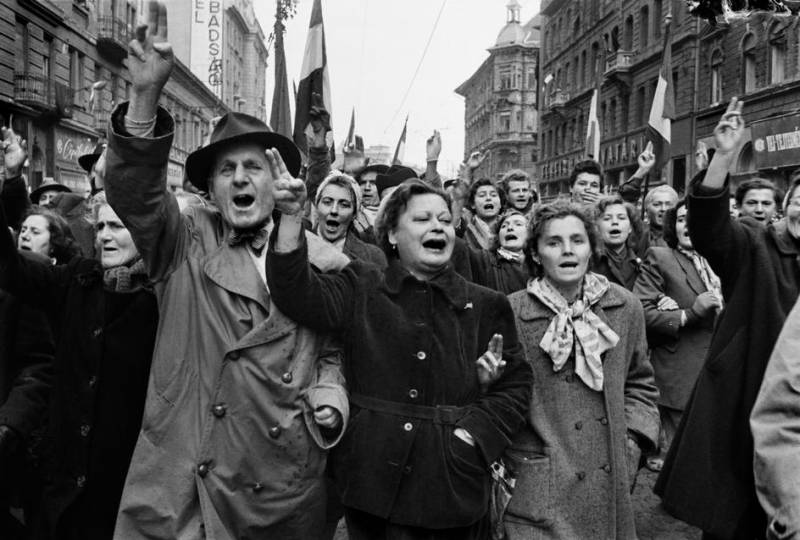
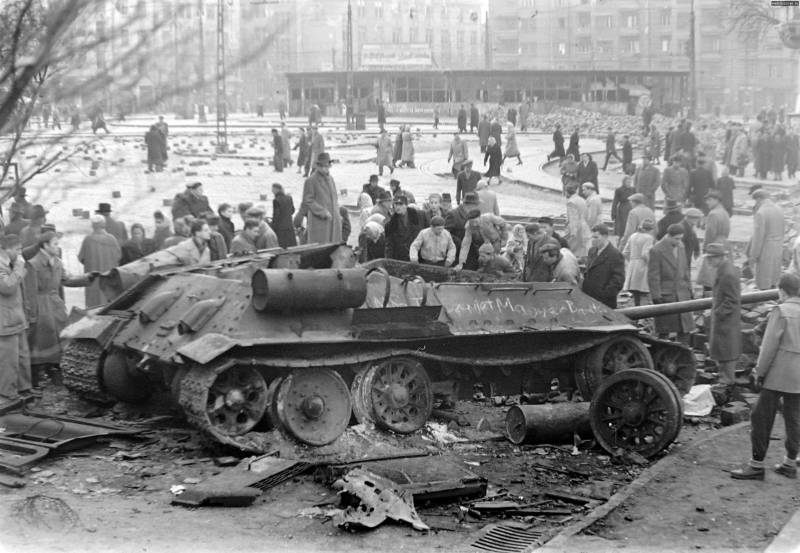
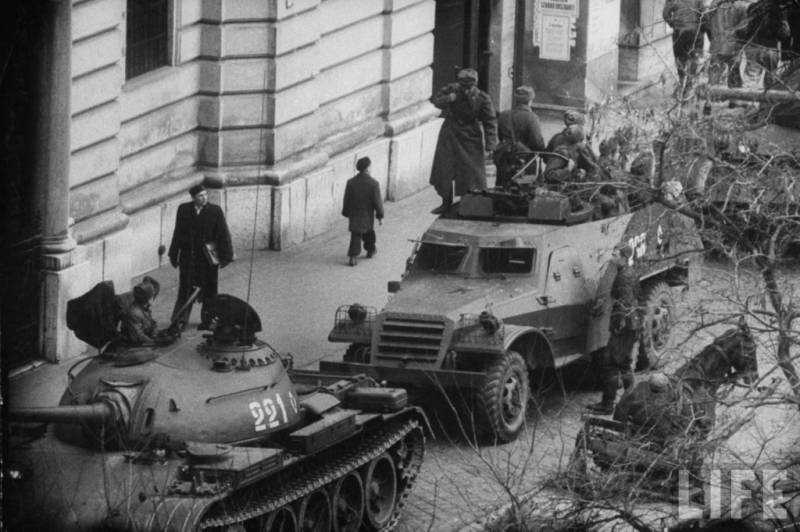
Information